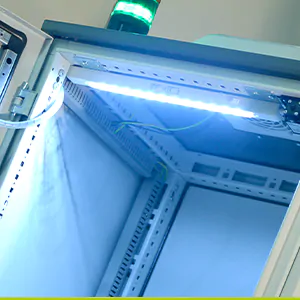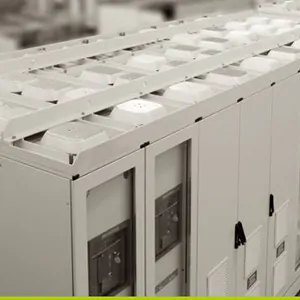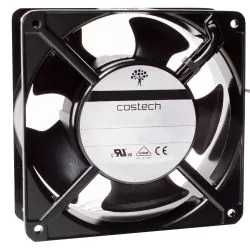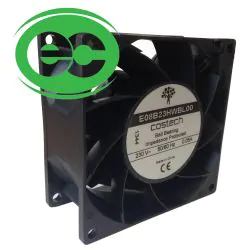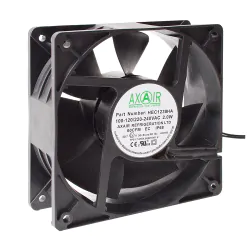Diagnose Enclosure Fan Issues
Diagnosing fan issues within an enclosure can prove difficult where the mechanical fault is very subtle.
For more basic issues there are a few easy steps to take to both diagnose and potentially prevent enclosure fan issues keeping downtime and repair costs down to a minimum. It is important to create a safe working environment for these checks. Physical inspections should only take place when the system and fan are shut down and locked out mechanically and electronically for safety. The individual undertaking the inspection should read the manufacturer’s maintenance guide and suitable attire should also be worn should the situation call for it such as a hard hat and safety glasses if the electrical cabinet is in a shop floor or potentially hazardous location.
These basic checks include checking the electronic cooling fan and system for leaks, build-up, missing parts or obstructions, checking tie down bolts and assuring that all the installed fan parts are aligned and operational. It’s common that the majority of issues occur during the start-up phase of an installation. The root cause of equipment failures can be mechanical or electrical, down to the impellers or negative performance. On an enclosure ventilating using a fan filter unit the primary component to check is the filter media. Over time the filter media can become blocked with dust and small objects (depending on its ingress protection rating), or it may have worn out over time. Most filter media can be washed up to 10 times but do need replacing regularly. Dirty filter media negatively affects the airflow and the cabinet can become contaminated which could affect not only the fan but all the equipment inside the enclosure.
Diagnosing Mechanical Issues
Mechanically, there are a number of potential issues.
Fan noise levels could be caused by an electronic cooling fan running in stall. Monitor the fan performance then analyse it against the fan curve to determine where on the curve it is operating. If the reading is to the left of the peak pressure the fan is running in stall. This can be fixed by reducing the pitch angle or seeing if the enclosure can be modified to eliminate high pressure loss sections. There are different types of noise that help to identify mechanical faults with the fan. Rough sounds suggest that the fans bearings have been brinelled. Brinelling occurs when the fan is vibrated in storage or transit indenting the bearing. This problem will surface shortly after the fan is installed. A squealing noise generally indicated that the bearings are either improperly greased, the bearings are loose so the sleeve or collar needs tightening or the bearings have not been properly tensioned.
Vibration, another mechanical problem, could occur if the impeller when out of balance, the shaft is bent or material such as dust or grease is sticking to the fan blades. The vibration could also be related to the impeller which may be damaged from handling abrasive materials or by loose material in the duct system. All of these issues can be rectified by replacing or cleaning in order to maintain efficient fan performance.
Where a larger airflow or pressure is required within an enclosure, a fan filter unit may not be sufficient. In this case larger electronics cooling fans can be used such as backward curved centrifugal fans or compact axial fans. If an impeller from a centrifugal fan is excessively noisy it may be a result of the impeller hitting the fan casing or inlet cone caused by the impeller been lose on the motor, the impeller been incorrectly mounted or not been centred. Additionally it could be that the inlet cone is damaged, the motor or drive shaft is bent, the bearings are loose or the cut-off in the fan has been damaged or is not secure. All of which can be replaced or fixed easily. The centrifugal impeller could also be damaged due to bulging. This happens when the impeller is built from lighter materials than the one specified therefore running above its recommended speed. If the axial fan is excessively noisy it could mean that the blades are lose or that the motor has moved. For both options the best thing to do is to contact the supplier. If the axial fan blades are bent they have most likely been damaged in transit in which case a replacement is needed or the fan has been running in stall creating excessive vibration thus bending the blades. This would need a replacement in addition to an inspection of air entry conditions to reduce the excessive turbulence.
Electrical Fan Issues
If having checked all of the mechanical diagnosis and no problem is evident, it may be an electrical one.
It is important to check that the electronics cooling fans have been installed with the incorrect airflow direction. On a compact axial fan this can be changed by simply reversing the impeller, however with a centrifugal fan all the wiring would be incorrect. To reverse the rotation of a single-phase motor simply interchange any 2 supply leads, for single phase refer to the directions on the motor box. In all instances a trained professional should always carry out any electrical changes.
If an electronic cooling fan within an enclosure won’t run, it may have the wrong electrical supply (this needs to be checked with the motor nameplate), a fuse could have blown which would need replacing after a motor circuit check has taken place. Electrical connections in the starter aren’t tight and would need tightening. Another reason it may not run is if the variable speed drive has been fitted wrongly making the electricity spike and the winding to fail, in which case the motor would need to be replaced. Many mechanical ventilation systems now use electrical speed controllers which if there is an imbalance can create an electrical hum. By switching to an auto-transformer the hum is nullified. It can also happen if the motor is not designed for the electric supply or there is a phase imbalance on three-phase motor, both of which can be easily checked then corrected. Another possible reason for the hum is if the motor has excessive clearance between stator and rotor which will make the motor run slower than normal speed. The best practice in this instance is to call the supplier.
If a fan motor is overheating or drawing high current there are a number of possible causes for this including faulty instruments which should be calibrated where necessary, incorrect power supply which can be checked on the nameplate, a three phase motor running with one phase disconnected meaning the windings would need to be replaced or the impeller has too much inertia for the motor power and can’t achieve full speed which could mean it needs a larger motor.
Other possible causes include excessive stopping and starting, requiring a reduction via a control system, the fan impeller is jammed resulting in a locked rotor which needs to be checked to make sure it can run freely. If it’s a backward curved impeller it could be running in the wrong direction reducing airflow with a forward curved centrifugal fan there may be insufficient resistance meaning that the fan speed must be lowered. If an axial fan, it could be overpitched which would just need re-angling and finally the gas density could be greater than the design which would need an increase in motor size to suit.
Other Enclosure Fan Issues
Although electrical enclosures and cabinets are generally efficient in their maintenance, often performance can drop below the required level. Low airflow can occur due to faulty instruments, poor installation or an insufficient running speed of the electronic cooling fan. Those also uneducated in calculating the dissipation of heat with enclosures may select the incorrect size fan. Consistently high airflow can cause electronics cooling fans to run excessively causing wear and tear, reducing the lifespan. Panels used to secure electricals inside a cabinet are usually designed for purpose but on the rare occasion that leakage around the base or roof areas occurs, system resistance is affected. A lower system resistance is evident on this occasion. Similarly using component coils and grilles that are too small will increase the system resistance and cause performances issues. In summary, enclosures or cabinets are manufactured and installed according to their designed specification and requirements but on occasion that performance is affected there are numerous possible causes. View the full range of compact axial cooling fans for electronics.
